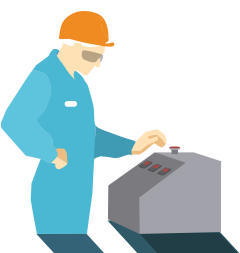The Strategies of Work System Design
Strategies in the design of work systems refer to humans involved, tasks to be performed and reasons relevant for initiating design activities.
Design strategies related to humans interacting within a work system
Design in human factors and ergonomics (HF&E) always addresses a user population, either specified or unspecified. The former provides delimiters and may specify a percentile range of the general population, defined according to characteristics relevant in the design such as physical and mental abilities, qualification, age, or gender. The latter intends to design for all and therefore intends to adapt the interface design to human individual needs.
In the context of work with machinery, specifications will be required being as inclusive as possible. According to HF&E design requirements, machinery shall be designed with proper regard to the physical and mental characteristics of the expected population of operators. This may refer to a broad range of aspects, such as
- human functional design and anthropometrics; i.e. size of visual field depends on body movements, human audio perception is omnidirectional, human body dimensions are limited,
- physical capabilities; i.e. limited lifting weight for repetitive lifting tasks, limited force for lever control,
- mental capabilities; i.e. limits in hearing range or memory span, and
- social requirements; i.e. communication needs for feedback and learning.
HF&E knowledge is about human possibilities and limitations that change and vary over time. Therefore, work system design shall preferable be adaptive to a broad range of operator population. In human-system interaction, this could refer to design of interfaces that for example
- allow the development of existing abilities of an operator and the attainment of new skills by implementing the interaction principle of suitability for learning, and
- shall be flexible enough to be adapted to the variation of skills within the operator population and potentially include special needs.
Design strategies related to human tasks and tasks in the work system
Work system design is an iterative and structured process, includes several phases (e.g. plan, do, check, adjust), involves a multidisciplinary design team (e.g. designer, user, OSH and ergonomics experts) and results in a new design or a redesign. The design process involves activities for analysis, synthesis, simulation, and evaluation. The design of work systems in HF&E is grounded on task orientation. At the beginning, the aim for design or redesign of the system is to be established and required functions will have to be substantiated. Allocation of task functions between workers and technical system components (e.g. automated tools) should take into account HF&E principles of human task design.
Decisions about function allocation will involve analysing the capabilities and limitations in fulfilling the requirements of the system of both the human and technical components of the planned system. This analysis and the subsequent allocation of functions to workers or equipment should create tasks and jobs, which have a positive effect on health, well-being and safety, as well as achieving the desired level of performance.
Design strategies related to reasons to initiate design activities
Design in HF&E may refer to work systems already in use or those available in the near future. This often refers to either corrective or prospective ergonomics, both being suitable to improve work systems design. While the latter often is limited to improve details of a work system under given circumstances, the latter looks forward in time and provides an opportunity for systematic design of work system according to HF&E normative standards.
Design strategies related to human abilities: Design for all (Universal Design)
This design strategy is extensive, comprehensive and forward-looking in that it inclusive to accommodate across the full spectrum of human abilities. A specific section on Design for all (Universal Design) provides more information.
References:
- Burgstahler S. (2021) Universal Design: Process, Principles, and Applications How to apply universal design to any product or environment. University of Washington: DO‑IT.
- EN 614-1. Safety of machinery – Ergonomic design principles – Part 1: Terminology and general principles.
- EN 614-2. Safety of machinery – Ergonomic design principles – Part 2: Interactions between the design of machinery and work tasks.
- EN 894-3 / ISO 9355-3. Safety of machinery – Ergonomics requirements for the design of displays and control actuators – Part 3: Control actuators.
- EN ISO 6385. Ergonomic principles in the design of work systems.
- EN 16710-2. Ergonomics methods - Part 2: A methodology for work analysis to support design.
- Kantowitz, B.H. & Sorkin, R.D. (1983). Human factors. Understanding people-system relationships. New York: Wiley.
- Lee, J.D., Wickens, C.D., Liu, Y. & Ng Boyle, L. (2017). Designing for People: An Introduction to Human Factors Engineering. Charlston: CreateSpace.
- Sanders, M.S. & McCormick, E.J. (1993). Human factors in engineering and design. New York: McGraw Hill.

